|
AND A COUSIN THE REMINGTON BEALS AN ARMY AND TWO NAVIES- PART 1
|
|
|
|
|
|
Remington, like Colt, was in business of arms making long prior
to the Civil War. They had been producing handguns since 1857 when
they introduced the Remington Beals Pocket Revolver. With
the outbreak of the Civil War all of the company's energy became
devoted to the military production of longarms and hand guns.
The martial hand guns produced during the Civil War period included
the Remington-Beals Army and Navy Model revolvers, the Remington
Models 1861 Army and Navy Revolvers, (a.k.a. as the
"Old Model Army" and "Old Model Navy") and the Remington New Model
1863 Army and Navy revolvers. Of these 6 models, I have but
3. They are the Remington-Beals Navy and the New Model 1863 Army
and Navy revolvers. Their pictures and descriptions follow:
|
|

From Top To Bottom Remington
New Model 1863 Single Action .44 Caliber Percussion Army Revolver
(1863-1875)
|
|
|
|
|
|
The Remington New Model 1863 Army Revolver represents Remington's
highest production martial pistol. Approximately 126,000 were manufactured
from 1863 to 1875. After Colt, it was the Northern government's
most purchased and issued pistol. Serial numbers of the New Model
Army continued from the Model 1861 Army. Reference sources
estimate this change from between serial number 15000 (Flayderman)
to 22000 (Reilly). This is probably due to a long transitional period
in which there was a gradual change over of the design features
between the two models. The earliest production models utilized
the 1861 frames and had a somewhat longer grip. The stamping "New
Model" on the barrel of the early models can also be noted to have
been stamped with a separate die. Nearly 110, 000 New Models were
purchased by the government during the Civil War, at prices between
$10.82 and $15.50 each. These prices were lower than Colt's and
by mid-1863, Colt was eliminated from the government contract
business. The State of New Jersey also purchased several thousand
for Civil War issue. The weapon pictured here is one of them and
is so marked with "N.J." on the barrel and frame.
|
|
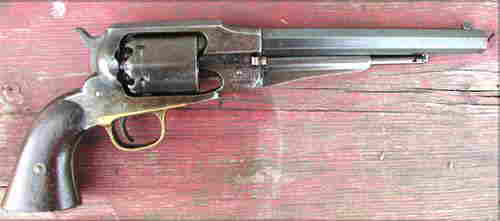
|
|

Right And Left Side Views of The New Model 1863 Single Action .44 Caliber Percussion Army Revolver
|
|
|
The New Model 1863 Army was the last of Remington's .44 caliber
percussion revolvers. Remington Armies were used from the beginning
to the end of the Civil War in all fields. They were considered
to be among the finest martial handguns of the day. The Remington
New Model 1863 Navy and it's forbearer, the Remington-Beals Navy,
also saw action during the war. Those models will be further pictured
and discussed in Parts Two and Three of this series of postings.
|
|
|
|
|
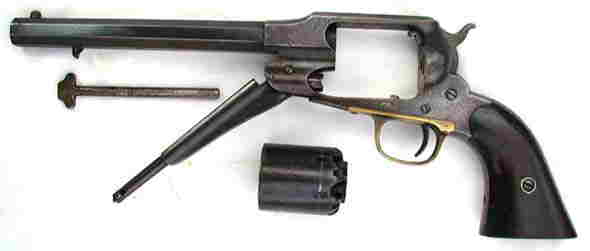
Left Side View of The New Model 1863 Army, With Loading Lever Dropped Cylinder Arbor Pin and Cylinder Removed
|
|
|
This single action weapon is caliber .44 with 5 groove rifling.
It is 14-1/2" overall and weighs 2 pounds, 14 ounces. The blued
barrel is 8 inches long. It is marked, on the top flat, "PATENTED
SEPT. 14. 1858 / E. REMINGTON & SONS. ILION. NEW YORK. U.S.A.
/ NEW-MODEL" in 3 lines. The left barrel flat at the front of the
blued frame is stamped "NJ" for New Jersey. The serial number, "61311"
is stamped on the bottom flat near the rear. It is only visible
when the loading lever is lowered. The front sight, threaded into
the barrel, is a pinched cylindrical iron blade 1/4'' long and 3/16"
high. It is positioned 3/8" back from the muzzle. Early production
models may be found with German silver or brass cone sights. Rear
sighting is done through the 2-7/16" "V" groove along the length
of the top strap. The loading lever catch, which screws into the
barrel, 1-9/16" back from the muzzle, is rounded at the front and
notched at the rear to hold the spring loaded catch at the front
of the loading lever.
|
|
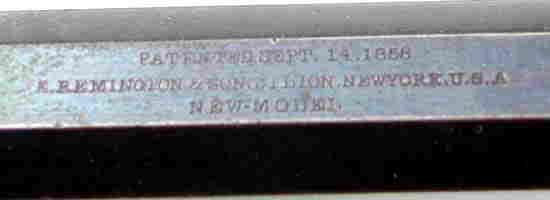
BARREL
ADDRESS
|
|
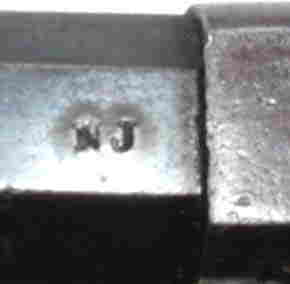
"NJ" BARREL STAMPING
|
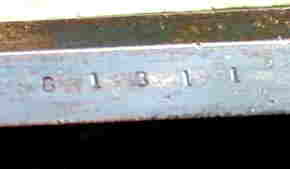
SERIAL
NUMBER STAMPING
|
|
|
|
|
The blued, one piece solid frame is marked with a "NJ" on the left
side under the cylinder opening. A "K" is also stamped on the frame
half way between the "B" stamped trigger guard and the grips. It
should be noted that the barrel threads are exposed on all specimens.
The front of the frame is inlet to receive the wings or finger lugs
of the 4-1/8" long cylinder arbor. The grip straps are blued. The
oval brass trigger guard is not plated. It is stamped with
a "B" on the left side, rear. The two-piece, oil-finished black
walnut wood grips are, unlike those purchased by the federal government,
unmarked.
|
|
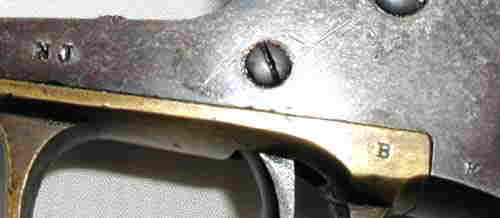
LEFT
FRAME AND TRIGGER GUARD INSPECTOR MARKS
|
|

BOTTOM VIEW OF CYLINDER ARBOR PIN
|

TOP VIEW OF CYLINDER ARBOR PIN
|
|
The cylinder pin arbor can only be withdrawn when the 4-1/2'' (from
arbor notch to end catch) loading lever is lowered. In normal position,
the loading lever prevents the accidental withdrawal of the cylinder
arbor. The arbor on this arm can be withdrawn it it's entirety when
the loading lever is lowered. However, on other arms of this type,
equipped with a "refined" cylinder arbor, it cannot be withdrawn
in it's entirety.
|
|
|
|
|
|
The six-shot blued cylinder is 2" long overall. It is 1-7/8" from
the cylinder front to the top of the shoulders between the nipple
wells. There is a small "P" stamped near the front of the cylinder.
A "P" stamping is also visible on the back of the cylinder, but
does not show up clearly in the photographs. Each shoulder
has intermediate safety rests milled into them. The stop slots are
rectangular. The cylinder diameter is 1.65 inches.
|
|

"P" INSPECTOR'S MARK ON CYLINDER
|
|
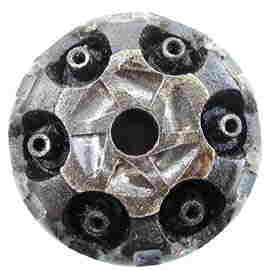
BACK OF CYLINDER
|
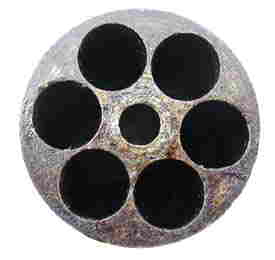
FRONT OF CYLINDER
|
|
|
|
|
The next posting, Part 2 of 3, of this Remington series will feature
the Remington New Model 1863 Single Action .36 Caliber Percussion
Navy Revolver. That will be followed by Part 3 of 3 which will
feature the Remington-Beals Single Action .36 Caliber Navy Model
Revolver (1862-1863).
|
|
|
Once again, a substantial amount of reference material and wording
came from Robert M. Reilly and his book "U.S. SMALL ARMS 1816
- 1865" and, as always, from Norm Flayderman's FLAYDERMAN'S
GUIDE TO ANTIQUE AMERICAN FIREARMS... AND THEIR VALUES".
|
|
|
My son and webmaster, Reed Radcliffe, again provided the
technical expertise to process these words and pictures to our web
page. He has also added numerous gun and other related show dates.
Please come back for Parts 2 & 3 which will be posted in the
following two weeks.
|
|
| Dave
Radcliffe
|
|